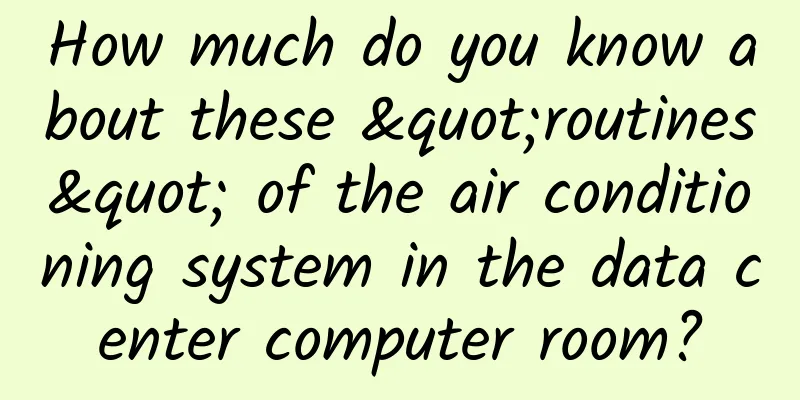How much do you know about these "routines" of the air conditioning system in the data center computer room?

|
Preface: As a chilled water system with centralized cold source, the "data center air conditioning system" has higher cooling efficiency, more centralized and less equipment, more stable operation, lower failure rate and maintenance cost. Chilled water air conditioning systems are commonly used in many large data centers abroad. However, there are many tricks in the air conditioning system of the computer room of the data center that you are not aware of. We will reveal them one by one below. Routine 1: Condensation and dripping There are many reasons for condensation and dripping during the commissioning and operation of the air-conditioning system. In summary, they are mainly: pipeline installation and insulation problems, loose connections between pipelines and pipe fittings, and between pipelines and equipment. The main reasons for water leakage are that the pipeline installation does not strictly comply with the operating procedures, the quality of pipelines and pipe fittings is poor, no careful inspection is carried out when entering the site, the system does not strictly perform water pressure tests according to the specifications, because the condensate pipe is too long, it collides with the ceiling during installation or the slope is difficult to ensure, or even the condensate pipe slopes backward, causing dripping. The condensate pipe of the air-conditioning unit has no water seal (negative pressure point) and the condensate of the unit air-conditioning cannot be discharged. The solution to the problems in the construction and installation of the condensate pipe is to discharge the condensate as close as possible to avoid the phenomenon of water accumulation in the condensate pipe slope backward or "fighting" with the hanging item; the cabinet condensate pipe should be equipped with a water seal according to the negative pressure size in the machine to ensure smooth discharge of condensate.
The main solutions to the above problems are: (1) Add insulation protection sleeves to the freezing pipes that pass through the wall to ensure the continuity and tightness of the insulation layer at the wall-penetrating part. (2) Before closing the ceiling, strengthen the cleaning and inspection of debris in the fan coil drip tray and other places. Fourth, strengthen the protection of the equipment drip tray, especially the inspection before closing the ceiling. (3) Strengthen the inspection of insulation materials upon arrival. Strengthen the technical briefing before construction and the inspection during construction. It is strictly forbidden to use large insulation sleeves to cover small pipes. Strengthen the insulation quality control of details such as elbows, valves, flanges and equipment interfaces to ensure that the insulation layer is tightly bonded to the outer wall of the pipe. Routine 2: Water circulation in air conditioning water system The water system is the most critical link in the construction of central air conditioning. Problems in the construction will directly affect the normal operation of the system. The most common problem of the central air conditioning chilled water system is the poor circulation of the chilled water system pipeline. The reasons for the poor circulation of the pipeline are: (1) The air conditioning water system pipes are not cleaned properly, which directly causes the air conditioning water system to be blocked. The solution is to strengthen pre-construction management, reasonably arrange pipeline elevations and slopes, try to avoid air pockets, and at the same time install exhaust valves at locations where air pockets are inevitable and connect the exhaust pipe outlet to a location that is conducive to system exhaust. (2) Due to the intersection of various professional pipelines, there was no coordination during construction, resulting in many air pockets in the pipeline network, affecting the circulation of the pipeline network During the construction process, several preventive measures should be taken: first, dirt and rust must be removed mechanically or manually before the installation of welded steel pipes. After the inner wall of the pipe is cleaned, the pipe mouth should be sealed for installation. During the pipeline construction process, the unsealed pipe mouth should be temporarily blocked to prevent dirt from entering. When connecting the pipes, welding slag, hemp and other debris should be cleaned in time. A relatively large drain valve is installed at the highest point of the pipe network. If the drain valve is too small, the drainage effect is poor, and the cleaning frequency is more frequent; if the drain port is not at the highest point, the drainage is not thorough. Temporary filters and bypass flushing valves should be appropriately added during the pipe network installation. Before connecting the equipment, the equipment should be cleaned in sections in combination with the water pressure test. After the cleaning work is completed, the water system circulation test operation is also required. The purpose is to flush the dirt in the pipe network to the filter, and then dismantle and clean the filter to remove the dirt. Routine 3: Pipeline and equipment positioning and elevation intersection Nowadays, the design drawings of computer room air conditioning projects are basically drawn using CAD. Although the installation professional design has made preliminary plans for the elevations of pipelines and equipment before drawing the construction drawings, detailed proofreading is often not carried out before the construction drawings are issued, which often results in serious overlaps in the elevations and positioning of pipelines in the professional construction drawings, causing great difficulties for project quality management and coordination. The height of the ceiling depends largely on the height of the duct section. The duct line should not be too long, otherwise it will be difficult to construct and other pipelines will also be difficult to arrange. For example, the duct cross-sectional area of a shopping mall is 2400mm×500mm. The larger the duct cross-sectional area, the larger the machine room. A larger machine room will also make noise and make it difficult to organize the return air. If the duct line is short, the fan power can be smaller. In this case, a horizontal unit can be used for hanging, and the machine room setting will be more flexible. In addition, the duct laying in the ceiling should also be done as follows: (1) Architectural design professionals should have a comprehensive understanding of the piping requirements of other professionals in order to reasonably determine the floor height and layout of pipelines: (2) Try to change the cross-sectional dimensions of the pipe according to the change in air volume to facilitate decoration, and partially increase the height of the ceiling; (3) The supply and return air ducts should be located in the same plane. When it is difficult to arrange the return air duct, the space inside the suspended ceiling can be used instead of the return air duct. (4) Comprehensive pipeline engineering design should be carried out for various pipelines in the building, and comprehensive pipeline drawings should be provided for complex buildings.
In summary, the improvement of the building ceiling height depends on efforts from many aspects. In view of the above problems, a comprehensive pipeline design should be carried out. The so-called comprehensive pipeline design is to arrange the various pipeline projects in the building in a unified manner, so as to find the problems existing in the design of various pipeline projects, and discuss solutions with relevant units, so that various pipelines occupy a reasonable position in the building space, and create conditions for the construction, operation, use, maintenance and management of pipeline projects. According to the different performance and use of pipelines, pipelines in buildings can be roughly divided into the following categories: (1) Grey water pipeline: including grey water collection and grey water supply; (2) Gas pipeline: There are gas fuel and liquid fuel; (3) Water supply pipelines: including domestic water supply, fire water supply, production water, etc.; (4) Drainage pipes: including domestic sewage, domestic wastewater, fire drainage, rainwater, other drainage, etc.; (5) Thermal pipelines: including steam or hot water required for heating, hot water supply and air conditioning air handling equipment; (6) Air ducts: including various air ducts in ventilation engineering and air conditioning systems, as well as compressed air pipes required by certain production equipment: (7) Power supply and distribution lines or cables: including power distribution, lighting distribution, weak current system distribution, etc., among which the weak current part includes shared television antennas, communications, broadcasting and fire alarm systems, etc. Therefore, the reasonable arrangement of various professional pipelines and the improvement of the effective use of the building space require close cooperation and mutual coordination of relevant professional designers. Under the unified coordination of the construction unit, all construction units and decoration units must check uniformly to meet their respective process requirements, so that the building can meet the requirements of economic rationality, hygiene and comfort, and increase the height of the hanging items under the premise of ensuring the decorative effect. Trick 4: Air conditioning noise exceeds standard The noise level of the air-conditioning terminal equipment exceeds the standard, which is a common equipment noise problem in HVAC projects. Since the fan coil technology is relatively mature, the noise indicators of fan coil products of many domestic manufacturers can meet the standards, but the situation of large air volume air conditioning units is not satisfactory. The actual noise value is often much higher than the product sample parameters provided by the manufacturer. The requirements for equipment noise parameters should be marked in the design, and sound insulation measures should be considered for the use of large air volume air conditioning units in the design. When the air conditioning equipment enters the site, it should be unpacked and inspected in time. Before the large air volume air conditioning unit is installed, it must be powered on for trial operation. If the noise exceeds the standard, it should be replaced, returned or the noise reduction measures should be modified and improved in time to avoid rework caused by discovering that the noise of the air conditioning unit exceeds the standard when the project enters the commissioning stage. In addition, reasonable construction can play a significant role in reducing noise. (1) Water system installation The installation of water pipes must strictly comply with national standards. The hangers for chilled water main pipes and cooling water pipes must use spring vibration-damping hangers, and the hangers cannot be fixed on the floor slabs. They should be fixed on beams as much as possible, or fixed with channel steel beams between beams. Water pipes passing through floors or walls must be sleeved, and the space between the sleeves and the water pipes must be sealed with flame-retardant materials. (2) Equipment installation Spring damping vibration absorbers are used for the installation of fresh air fans and air conditioners, soft connections are used to connect fans to air ducts, soft joints are used to connect fresh air units to water pipes, spring-protected hooks are used for fan coils, and hoses are used to connect fan coils to water pipes. Sound-absorbing treatment is performed on the air-conditioning room, such as using sound-insulating materials to make enclosure structures in the air-conditioning room to prevent equipment noise from being transmitted outward, or sound-absorbing materials are affixed in the room, and concave-convex sound-absorbing panels are used as the walls or ceiling panels of the room to enhance the sound absorption effect. Doors and windows should be minimized in the room, and sound-absorbing doors and windows or sound-absorbing blinds should be used to minimize the transmission of equipment noise. (3) Air system installation The production and installation of air ducts must be carried out in strict accordance with national standards. Impedance silencers shall be installed at the inlet and outlet of the fan, silencer louvers shall be used at the fresh air inlet, silencers shall be installed at appropriate parts of the air duct, silencer elbows shall be installed at the elbows of the air duct, and the outside of the air conditioner and fresh air silencer shall be insulated with high-quality thermal insulation materials. Like the static pressure box, the inside shall be covered with high-quality sound-absorbing materials. Since the supply and return air ducts both use low wind speed and large air volume to reduce noise, the cross-sectional area of the air duct is relatively large. If the installation strength and overall rigidity of the air duct are insufficient, friction and vibration noise will be generated. It is recommended that rubber vibration damping pads be used for the air duct hanger as much as possible to ensure that the air duct does not generate vibration noise. Trick 5: Problems with air conditioning installation The air conditioning installation process involves the cooperation between multiple professionals. The lack of good communication between the professionals often causes many inconveniences to the construction and even affects the construction period. There are mainly the following problems: (1) No specific requirements for the construction of air ducts were put forward for civil engineering. For example, when laying bricks for ventilation shafts, cement mortar should be used to plaster the surface to ensure that the inner wall of the air duct is smooth and airtight. (2) The dimensions of the holes reserved for ventilation ducts in concrete walls, floor slabs, etc. were not provided to the civil engineering professionals and were not included in the civil engineering drawings. This resulted in holes being drilled during construction, adding unnecessary expenses and even affecting the strength of the building structure. In particular, the reserved holes for lifting holes of large equipment, ventilation ducts of civil air defense projects, pressure measuring tubes, etc., will be difficult to handle if the pre-embedded work is not done properly. (3) No requirements were put forward for drainage in the machine room, resulting in the lack of drainage facilities in the machine room. The refrigeration machine room should be equipped with drainage ditches and a nearby sump, and a drainage pump with a water level controller should be installed in the sump. In particular, there are many equipment in the basement, and the chillers, filters, etc. must be flushed regularly. If the system leaks and there are no drainage facilities in the machine room, the equipment will be flooded. In response to these problems, we should strengthen the cooperation of various disciplines, and propose preventive measures in the design stage and the construction drawing review stage. During the construction of air-conditioning projects, some problems (routines) are often exposed, which requires us to do a meticulous quality control work. Before the construction of the air-conditioning project, we must understand the design intent, be familiar with the construction drawings of various disciplines, prepare a good construction organization chart, grasp the control points of the project, and do a good job of pre-, mid-, and post-control point management. |
<<: How many of the 7 core technologies that operate blockchain do you know?
>>: Distinguish between fat AP and thin AP, full WiFi signal coverage will be easy
Recommend
Countries are competing to deploy 6G commercial services, and South Korea is ahead of the United States and Japan to seize the opportunity
After becoming the first country in the world to ...
In-depth analysis of the Raft protocol and KRaft practical demonstration
1. What is the Raft protocol? The Raft protocol i...
10 SD-WAN projects to watch
[[323303]] GlobalConnect | Versa Networks GlobalC...
Pairing private networks with 5G to boost smart city development
Consider the superior performance that 5G offers ...
How to estimate the power configuration of 5G base stations?
5G base station construction, supporting faciliti...
Whether to adopt blockchain is always a matter of choice
Blockchain is currently a technology that has att...
What? You need to change your SIM card to use 5G?!
Since 5G was officially put into commercial use l...
The WiFi at home is getting slower and slower. Do these ten things to make the Internet speed fly again
The broadband access at home now often starts at ...
Among China Mobile, China Unicom and China Telecom, which 100M broadband is more reliable and cost-effective?
Currently, 100M fiber-optic access to homes has b...
Let ChatGPT tell you how to build a lossless network that supports ChatGPT computing power
With the acceleration of digital transformation o...
Network communication and governance, who is better? Comparison of Envoy and Nginx at the architectural level
[[281978]] Nginx was a very representative open s...
What do edge computing and 5G mean for the Internet of Things?
Most IoT architectures in the business world are ...
Talking about new IP technology in data centers
Ethernet technology, also known as IP technology,...
AT&T is offering six months of Stadia Pro for free to 5G and fiber customers
Carriers are expanding their growing list of free...



![[Black Friday] FlipperHost: 2GB memory KVM monthly payment starts at $4.9, 4 data centers in Los Angeles and other places](/upload/images/67cac473c3319.webp)





